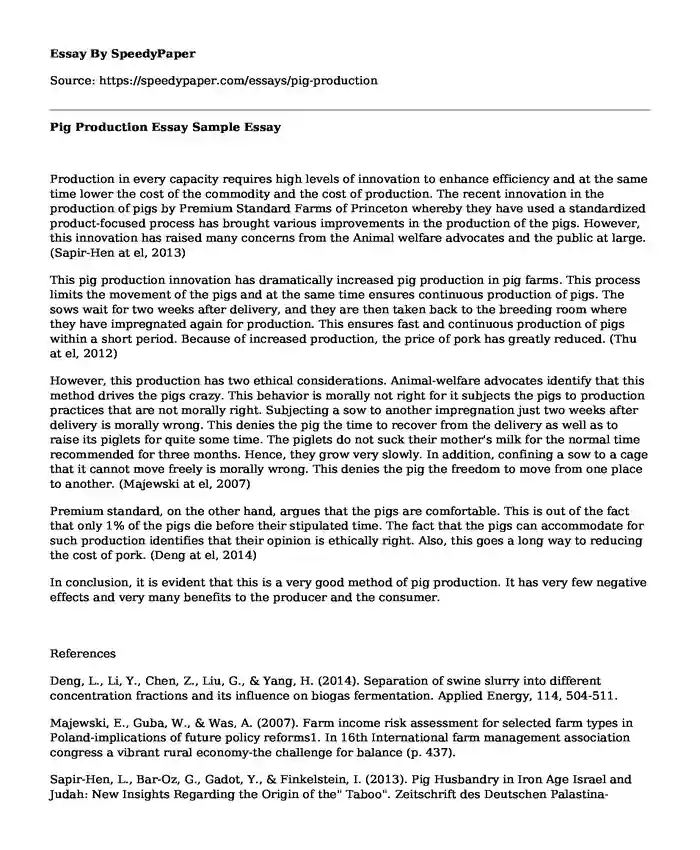Production in every capacity requires high levels of innovation to enhance efficiency and at the same time lower the cost of the commodity and the cost of production. The recent innovation in the production of pigs by Premium Standard Farms of Princeton whereby they have used a standardized product-focused process has brought various improvements in the production of the pigs. However, this innovation has raised many concerns from the Animal welfare advocates and the public at large. (Sapir-Hen at el, 2013)
This pig production innovation has dramatically increased pig production in pig farms. This process limits the movement of the pigs and at the same time ensures continuous production of pigs. The sows wait for two weeks after delivery, and they are then taken back to the breeding room where they have impregnated again for production. This ensures fast and continuous production of pigs within a short period. Because of increased production, the price of pork has greatly reduced. (Thu at el, 2012)
However, this production has two ethical considerations. Animal-welfare advocates identify that this method drives the pigs crazy. This behavior is morally not right for it subjects the pigs to production practices that are not morally right. Subjecting a sow to another impregnation just two weeks after delivery is morally wrong. This denies the pig the time to recover from the delivery as well as to raise its piglets for quite some time. The piglets do not suck their mother's milk for the normal time recommended for three months. Hence, they grow very slowly. In addition, confining a sow to a cage that it cannot move freely is morally wrong. This denies the pig the freedom to move from one place to another. (Majewski at el, 2007)
Premium standard, on the other hand, argues that the pigs are comfortable. This is out of the fact that only 1% of the pigs die before their stipulated time. The fact that the pigs can accommodate for such production identifies that their opinion is ethically right. Also, this goes a long way to reducing the cost of pork. (Deng at el, 2014)
In conclusion, it is evident that this is a very good method of pig production. It has very few negative effects and very many benefits to the producer and the consumer.
References
Deng, L., Li, Y., Chen, Z., Liu, G., & Yang, H. (2014). Separation of swine slurry into different concentration fractions and its influence on biogas fermentation. Applied Energy, 114, 504-511.
Majewski, E., Guba, W., & Was, A. (2007). Farm income risk assessment for selected farm types in Poland-implications of future policy reforms1. In 16th International farm management association congress a vibrant rural economy-the challenge for balance (p. 437).
Sapir-Hen, L., Bar-Oz, G., Gadot, Y., & Finkelstein, I. (2013). Pig Husbandry in Iron Age Israel and Judah: New Insights Regarding the Origin of the" Taboo". Zeitschrift des Deutschen Palastina-Vereins (1953-), (H. 1), 1-20.
Thu, C. T. T., Cuong, P. H., Van Chao, N., Trach, N. X., & Sommer, S. G. (2012). Manure management practices on biogas and non-biogas pig farms in developing countries-using livestock farms in Vietnam as an example. Journal of Cleaner Production, 27, 64-71.
Cite this page
Pig Production Essay Sample. (2022, Mar 01). Retrieved from https://speedypaper.net/essays/pig-production
Request Removal
If you are the original author of this essay and no longer wish to have it published on the SpeedyPaper website, please click below to request its removal:
- Effects of Exports Amount on the GDP of African Countries
- Summary of the Understanding the Patient. Free Essay on Counseling.
- LES Whiskey: Marketing Essay Example
- Free Essay Describing the Case of Australia: Mental Health System Change
- Free Essay Example on the Role of Place in Shaping Culture
- Catholic Social Teaching in Business
- Paper Example: Diverse Learning Environments
Popular categories





